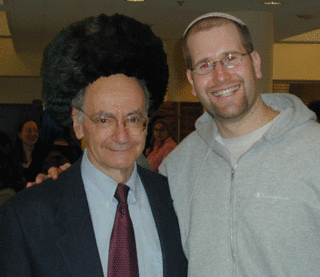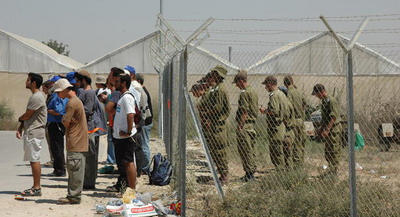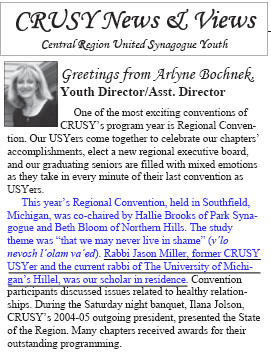Category: Uncategorized
Night of Hilarity and Charity
“This event gives all of us who benefit so much from YAD’s programs a chance to give back to our Jewish community,” says Elissa Miller of the upcoming Second Annual Night of Hilarity and Charity sponsored by the Jewish Federation’s Young Adult Division. Miller and Rebecca Levin are co-chairs for the event, which will be held once again at the Improv Inferno, located in downtown Ann Arbor, on Thursday, September 22, 2005, and this year features comedian Randy Kagan.
Both Miller and Levin are somewhat new to the Ann Arbor Jewish community. Miller, a real estate agent with Reinhart, is originally from the Detroit suburbs, and lived in New Jersey and New York before moving to Ann Arbor with her husband, Rabbi Jason Miller, who is Assistant Director of the University of Michigan Hillel Foundation, and their son Josh in 2004. Levin is a Milwaukee native who moved to Ann Arbor with her husband Josh, a resident at the University of Michigan Medical School, when she began her studies at the Law School in 2003. They became involved with the Young Adult Division because they wanted to give back to their new community. “A vital Jewish community that offers innovative programming to young adults and young families is important for me. Ann Arbor’s YAD is great — it has helped us meet so many great families this past year,” says Miller.
The two hope to build upon the great success of the first Night of Hilarity and Charity last December, by filling every seat in the room, and encouraging members of the community between the ages of 25 and 40 to support the Jewish Federation’s Annual Campaign.
“We’re also very excited about the fact that Randy Kagan will be performing this year,” says Levin. Kagan’s intelligent and off-the-cuff humor has landed him on numerous television shows, including In Living Color and Weekly World News, performances with Gary Shandling and Dennis Miller, and at stand-up showcases including Comic Strip Live, The Dennis Miller Show, VH1 Stand Up Spotlight, Late Night with Craig Kilborne. This will be his first trip to Ann Arbor.
“The needs of the Jewish community here in Ann Arbor and abroad are always growing,” says Levin. “With Night of Hilarity and Charity, we hope to share the serious message of the Jewish Federation’s mission, provide people with a great time and the chance to celebrate the great work we make possible when we give to the Annual Campaign.”
YAD’s Night of Hilarity and Charity at Improv Inferno begins with hors d’oeuvres at 6:30 pm. The show begins promptly at 7:00pm. You will be asked for your commitment to the Jewish Federations 2006 Annual Campaign at this event. The minimum level of annual giving for this event begins at $18. Gifts to the 2006 Annual Campaign can be paid through December 31, 2006. Tickets are $25, and can be purchased online at www.jewishannarbor.org/yce or by calling 677-0100. Improv Inferno is located at 309 S. Main Street, Ann Arbor.
US Jews pray time change won’t harm morning worship
By AVI MAYER/JTA
It’s 6:45 a.m. and the carpeted study room of the Kemp Mill Synagogue in suburban Washington is already abuzz with the clicking of tefillin and the murmur of worship.
Twenty men and women stand as the prayer leader recites the opening blessings of Shacharit, the morning prayer, leading the Silver Spring, Md., congregation in the thrice-daily ritual that is an integral part of the lives of observant Jews.
By March 2007, the 40-minute commute that many of the Kemp Mill supplicants take to get to their jobs in Washington may present them with a Hobson’s choice: morning services or getting to work on time.
On July 21, Congress approved an amendment to the Energy Policy Act that will extend daylight-savings time by four weeks starting in spring 2007 – three in March and one in November.
Jewish groups aren’t smiling.
On July 19, the United Synagogue of Conservative Judaism urged members of Congress to oppose the provision.
“The proposed change in daylight-savings time from April through October to March through November would result in a later sunrise that will produce an undue hardship on religious Jews,” wrote the USCJ’s public policy director, Mark Waldman. “Our prayers that cannot occur until after sunrise last about 30-40 minutes. The later sunrise will place a hardship on observant Jews that are required to recite their morning prayers and then must commute to the workplace by 9:00 a.m.” Waldman also cited child-safety concerns in opposing the measure.
“The extension of daylight-savings time will force children to walk to school in pitch black streets during the time of year when inclement weather is more likely,” he wrote. “The last time daylight-savings time was extended, in the early 1970s, there were numerous reports of children being injured in the streets as they walked to school in the dark. It is not unreasonable to think that this will happen again.” The following day, the Orthodox Union’s Institute for Public Affairs called on its members to oppose the proposal.
“Pushing sunrise back to 8:00 a.m. or later would make it impossible for those in certain parts of the United States to pray Shacharit (morning prayers) before work,” the O.U. said.
From the Forward (forward.com)
Oprah Touches a Sore Spot
By Mark Levenstein
Oprah Winfrey is better known for promoting empathy than creating controversy. But the queen of television talk is angering both Jews and Arabs with her recent examination of life for women in the Middle East.
Some pro-Israel advocates are upset over a profile of a would-be female suicide bomber that appeared in the June issue of O, The Oprah Magazine. Arab critics are complaining about an April 25 segment aired on Winfrey’s daily television talk show, which focused on Rania Al-Baz, the Saudi Arabian television personality who spoke out after being brutally beaten by her husband.
In both cases, Winfrey’s camp is standing by its work.
The magazine article, written by David France and titled “Love and Terror,” attempts to “make sense” of the growing number of women and children suicide bombers, and focuses on the story of 18-year-old Yusra Abdu. It highlights Abdu’s relationship with the Nablus head of the Democratic Front for the Liberation of Palestine, Hani Akad.
According to the article, which ran as an installment in O magazine’s “Rescuing the World’s Girls” series, Abdu first approached Akad, saying: “I want to become a suicide bomber.”
Allegedly, the pair quickly fell in love and became engaged before eventually breaking up at Akad’s insistence. Then Abdu was approached by another man who convinced her that it was time for her to become a suicide bomber. After waffling, France writes, Abdu backed out of her fatal mission. Within days, she was arrested by the Israelis.
In an e-mail alert, Deborah Passner, a senior researcher at the Committee for Accuracy in Middle East Reporting in America, objected to the “theme of Palestinian victimization” in the article. Citing allegations that Akad had recruited other women for suicide missions, Passner complained: “By what logic does a series on rescuing girls in peril romanticize a man who has tried to lure young women to their deaths?”
A widely circulated e-mail criticizing the story complained that “not once does the article raise the question of what kind of society not only breeds but venerates suicide bombing, nor whether suicide bombing can ever be justified as a means of political expression.”
O is standing by the article. In an e-mail to the Forward, magazine spokeswoman Elizabeth Dye wrote that when dealing with “subjects [that] are often politically and emotionally charged, we make every effort to present a fair and unbiased report.”
Winfrey’s camp also is defending the television segment on Al-Baz, which was aired as part of a special episode of The Oprah Winfrey Show. The episode, titled “Oprah Takes You Around the World,” featured Winfrey hosting women from 11 countries.
In an e-mail to the Forward, Harpo Productions spokeswoman Carly Ubersox stated that Al-Baz’s story was “presented accurately” and was “always intended for inclusion in a show that examined the different lives of women from various countries.” [more…]

Just got back late last night from 5 days in Las Vegas (no gambling, just some much needed relaxation and some great Vegas shows). I read Freakonomics: A Rogue Economist Explores the Hidden Side of Everything by Steven D. Levitt and Stephen J. Dubner. What a phenomenal book that I found difficult to put down (might have helped that I read 80% of it at one of Mandalay Bay’s pools and the other 20% on the flight home).
Some of the questions that Levitt and Dubner answer are:
- Which is more dangerous, a gun or a swimming pool?
- What do schoolteachers and sumo wrestlers have in common?
- Why do drug dealers still live with their moms?
- How much do parents really matter?
- What kind of impact did Roe v. Wade have on violent crime?
Reading this book will definitely give one something to talk about in casual conversation as I discovered on the plane when the woman next to me was reading over my shoulder and inquired about the book. I highly recommend this great read.

A blog has now surfaced to give people the chance to discuss the future of the Jewish Theological Seminary and specifically the search for a new chancellor.
CRUSY Regional Convention
My teacher Rabbi Ismar Schorsch has announced his retirement from The Jewish Theological Seminary effective at the end of June 2006. While twenty years is quite a length of time for his chancellorship, I am certain he could continue to be Chancellor for years to come. During my six years at the Seminary I watched the institution improve by leaps and bounds each year. This was no doubt due to the contributions of many, but ultimately must be attributed to the leadership of Chancellor Schorsch. As a classroom teacher he was simply magnificient. Each Friday morning of one particular semester a few years ago, I was blown away listening to his lectures on the famous Jewish historians. As he helped the class move from their scholarly texts to their context in scholarship I recall feeling that I could sit and listen to Dr. Schorsch all day. The only famous Jewish historian he omitted from that course was himself.
Here is the NY Times coverage of his announcement (from June 17, 2005)
Jewish Theological Seminary to Lose Its Longtime Leader
By JOSEPH BERGER
Rabbi Ismar Schorsch, who shepherded the Jewish Theological Seminary through 19 years of robust institutional expansion that also saw recurring tensions over the Conservative movement’s traditional standards, has announced that he will retire as chancellor a year from now.
The movement, which combines an adherence to traditional Jewish law with an acceptance of contemporary change, has been through a complicated era under the leadership of Dr. Schorsch, who is 69. In an interview yesterday, he spoke of the difficulty of reconciling those members who prefer more rigorous observance and with those who seek a more contemporary refashioning of worship – one that would, for example, permit more participation by women and gays.
“The long-term question is whether the center can hold, and that is the mission of the Conservative movement, to make sure that the center does not collapse,” he said.
The seminary, at 122nd Street and Broadway in Manhattan, is the heart of the Conservative movement of 1.3 million Jews, and its chancellor is seen as the movement’s head. The seminary prepares most of the movement’s rabbis and cantors, and generates the scholarship that guides movement policies.
Dr. Schorsch, a soft-spoken, courtly refugee from Nazi Germany who is a scholar of European Jewish history, took the helm in March 1986, a year after the movement ordained its first female rabbi. But the issue of how well women are being integrated into leadership and worship continues to percolate, with a recent study finding that most of the 188 female rabbis either work in nonpulpit jobs, as assistant rabbis, or with small congregations. (There are 1,600 Conservative rabbis in all.)
The movement’s Rabbinical Assembly voted in 1992 not to ordain gays as rabbis and said that rabbis should not perform same-sex marriages, a stance Dr. Schorsch supported. But the assembly did not declare the ban a binding standard.
The movement, once American Judaism’s largest, has been unable to expand the ranks of adherents. Two polar tugs are blamed: the attraction of more ardent observance and the losses to Reform Judaism of interfaith couples uncomfortable with the movement’s clinging to the centuries-old principle that Jewish identity stems from the mother alone.
Last winter, articles in Jewish newspapers reported that the seminary had a deficit of at least $40 million and that, to buttress its endowment, was planning to sell property on the West Side. Dr. Schorsch said reports of the financial problems were “overblown.”
Dr. Schorsch turned the seminary into a full-fledged university, with a wider range of graduate programs. In 1994 there were 500 students and 90 faculty members; today there are 700 and 120 respectively.
Dr. Schorsch said that he raised close to a half billion dollars in annual campaigns and $265 million in a capital campaign.
Dr. Schorsch said he will take a sabbatical and then resume teaching and writing.
“I have always wanted to step down in top form,” he said. “I am mindful of the harm one can do by staying on too long. I did not want to be guilty of that mistake.”
Global access to some of Jewish history’s most outstanding literary treasures is now just a mouse click away through JTS Library Treasures, a new online resource of The Library of The Jewish Theological Seminary.
 Prepared with the generous support of George Blumenthal of New York City and the extraordinary photographic skills of Ardon Bar Hama of Raanana, Israel, the site features several manuscripts from The Library’s exceptional collection, including the Rothschild Mahzor, the Prato Haggadah, and the Esslingen Mahzor, as well as Genizah fragments representing Maimonides and Judah Halevi.
Prepared with the generous support of George Blumenthal of New York City and the extraordinary photographic skills of Ardon Bar Hama of Raanana, Israel, the site features several manuscripts from The Library’s exceptional collection, including the Rothschild Mahzor, the Prato Haggadah, and the Esslingen Mahzor, as well as Genizah fragments representing Maimonides and Judah Halevi.
Founded in 1893, the Library at JTS is recognized today as the greatest Jewish library in the Western Hemisphere. Its collection includes close to 400,000 volumes, including 25,000 rare books, 12,000 manuscripts, and much more. Among the collection’s highlights are its approximately 40,000 fragments from the Cairo Genizah, its collection of kettubot (Jewish wedding contracts), and its unparalleled collection of haggadot (the story of the Jews’ exodus from Egypt). The Library is also host to the world’s largest collection of Hebrew incunabula, early books, printed before 1501.
“The Library recognizes that as important as it is to collect and preserve the literatures and treasures of past, these materials are worth little if they remain eternally on the shelf. Our ultimate goal is to make the cultural heritage of the Jewish people available to the world at large. Current technology, the generosity of George Blumenthal and the talent of Ardon Bar Hama is allowing this to happen,” said Dr. David Kraemer, Joseph J. and Dora Abbell Librarian at JTS.
As founder and past Chairman of NTL, the largest cable television company in the United Kingdom, Blumenthal came to understand how transformative high speed Internet access could be in sharing the heritage of the Jewish people free of charge. Currently the founder and Chairman of Cellular Communications Inc (Ohio and Michigan), Cellular Communications (Puerto Rico) and Cellular Communications International (Italy), he is responsible, together with Bar Hama for developing a number of educational projects that share the treasures of rare Jewish documents and archeological objects with the world at no charge.
The Robin’s Nest Saga
 For a period of a few weeks, our family enjoyed some very special guests right outside our living room’s bay window. A robin bird, the official state bird of Michigan, laid a nest in our cherry blossom tree in a perfect location for viewing (both from inside and outside).
For a period of a few weeks, our family enjoyed some very special guests right outside our living room’s bay window. A robin bird, the official state bird of Michigan, laid a nest in our cherry blossom tree in a perfect location for viewing (both from inside and outside).
I took photos of the nest from the time she lay the eggs to the day before the three babies flew the coup. Having never known much about the Robin bird I enjoyed watching her and learning more about her species on the Web. Our family loved listening to her sing and checking up on her each day.
I’ve uploaded some of the photos I took of this experience and will also upload some video clips soon. Enjoy!

